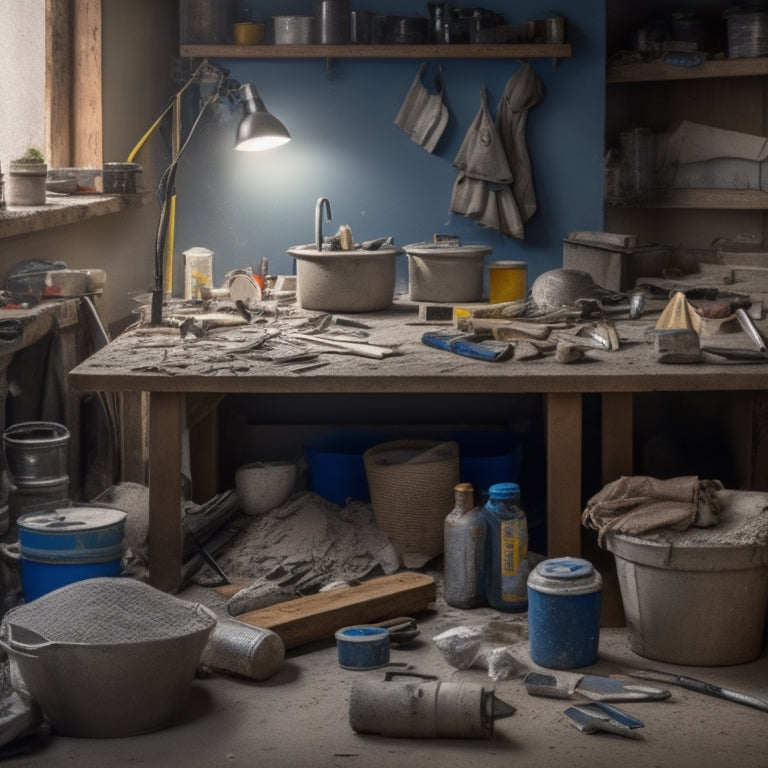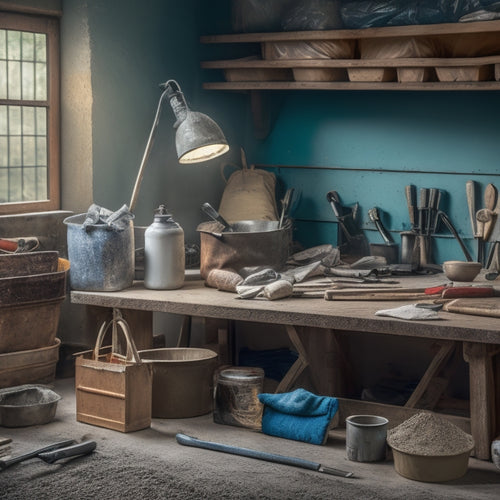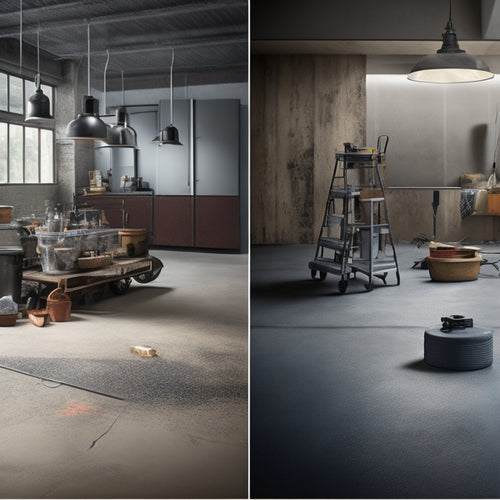
Top Tools for Quick Fix Concrete Repairs
Share
When tackling quick fix concrete repairs, you'll need a range of specialized tools to guarantee durable, long-lasting results. You'll require mixing and measuring tools like sturdy buckets, digital scales, and mixing paddles to achieve accurate proportions and uniform consistency. Crack sealants, such as acrylic, polyurethane, and epoxy, will depend on crack size and location. Surface preparation tools like scrapers, grinders, and vacuums are essential for thorough cleaning and preparation. Finishing tools like tamping tools and trowels help achieve a smooth finish. Safety gear, including hard hats and gloves, and cleanup equipment will also be necessary. To guarantee a successful repair, you'll want to explore these tools and techniques in more depth.
Key Takeaways
• A sturdy mixing bucket with measurement markings is essential for accurate concrete mixing.
• Digital scale or measuring cups and spoons provide precise measurements for concrete repair materials.
• Choosing the right crack sealant based on crack size, location, and environmental conditions is crucial for effective repairs.
• Surface preparation tools like scrapers, grinders, and vacuums are necessary for thorough cleaning and strong bonding.
• Personal protective equipment like hard hats, safety glasses, and dust masks are vital for preventing injuries and exposure to hazards.
Essential Mixing and Measuring Tools
You'll need a reliable set of mixing and measuring tools to accurately proportion and combine your concrete repair materials. This guarantees the final product meets the required specifications, and your repair is durable and long-lasting.
A sturdy mixing bucket, preferably with measurement markings, is a must-have. You'll also require a mixing stick or trowel with a sturdy handle and a flat, wide blade to effectively mix and scrape the sides of the bucket.
Measuring accuracy is essential in concrete repair. Invest in a digital scale or a set of measuring cups and spoons to secure precise measurements.
When it comes to mixing techniques, a thorough understanding of the material's instructions is crucial. Follow the recommended mixing order, and mix in small batches to avoid over-mixing, which can lead to a weak and porous repair.
A mixing paddle or drill attachment can also be useful in achieving a uniform consistency. By mastering the art of mixing and measuring, you'll be well on your way to achieving professional-grade concrete repairs.
Concrete Crack Repair Essentials
With your mixing and measuring skills honed, it's time to tackle the most common concrete repair issue: cracks. When it comes to concrete crack repair, you'll need to choose the right crack sealants options and repair mixtures types for the job. Here's a breakdown of some popular options:
| Sealant Type | Properties | Usage |
|---|---|---|
| Acrylic | Flexible, water-based | Hairline cracks, interior applications |
| Polyurethane | Rigid, chemical-resistant | Larger cracks, exterior applications |
| Epoxy | High-strength, chemical-resistant | Structural repairs, high-traffic areas |
| Silicone | Flexible, UV-resistant | Expansion joints, exterior applications |
| Hybrid | Combines benefits of above | High-performance repairs, varied applications |
When selecting a crack sealant, consider the size and location of the crack, as well as the type of concrete and environmental conditions. Always follow the manufacturer's instructions for application and curing times to guarantee a successful repair. By choosing the right sealant and following proper application procedures, you'll be able to effectively repair cracks and extend the life of your concrete structure.
Surface Preparation Must-Haves
Before applying any repair mixture or sealant, thoroughly clean and prepare the surface to guarantee a strong bond between the old and new concrete.
You'll need the right tools for surface preparation to make certain a successful repair. Start by removing dirt, grime, and old adhesive residue using surface cleaning techniques such as pressure washing, wire brushing, or scrubbing with a stiff broom.
Next, assess the substrate using methods like sounding, probing, or visual examination to identify any cracks, voids, or weak spots. This will help you determine the best course of action for your repair.
In your toolkit, you should have a scraper or grinder to remove old coatings or roughen the surface, as well as a vacuum or blower to remove dust and debris. A putty knife or trowel can be used to remove old sealants or fill small voids.
Don't forget safety gear like gloves, goggles, and a dust mask to protect yourself from the cleaning process.
Finishing and Smoothening Tools
As you move on to the final stages of your quick fix concrete repair, you'll need the right tools to achieve a smooth, even finish.
Two crucial tools for achieving a smooth, even finish are a tamping tool and a finishing trowel, which help remove excess material and flatten the surface. The tamping tool is used to compact the concrete, ensuring it's dense and even, while the finishing trowel is used to apply the final layer of concrete and smooth out any imperfections.
When using a finishing trowel, it's important to employ proper trowel techniques to achieve a smooth finish. This includes holding the trowel at a 45-degree angle and using long, sweeping strokes to spread the concrete evenly.
You can also use different smoothing methods, such as using a trowel with a curved blade or a specialized smoothing trowel, to achieve the desired finish.
Safety and Cleanup Equipment
You'll need to don the right personal protective equipment (PPE) and have a plan in place for efficient cleanup to make certain a safe and successful concrete repair project. Safety gear is essential to prevent injuries and exposure to hazardous materials. Make sure you have the following essentials:
| Safety Gear | Cleanup Supplies | Purpose |
|---|---|---|
| Hard hat | Broom and dustpan | Protects head from falling debris, sweeps away debris |
| Safety glasses | Disinfectant spray | Shields eyes from chemical splashes, sanitizes surfaces |
| Dust mask | Trash bags | Filters out airborne particles, contains waste |
| Gloves | Mop and bucket | Protects hands from chemicals and abrasion, cleans up spills |
| Steel-toed boots | Hose or pressure washer | Protects feet from heavy objects, rinses away debris |
Remember to always follow safety protocols and manufacturer instructions when using these tools and equipment. Make certain you have a first aid kit on hand and a plan for emergency situations. By prioritizing safety and cleanup, you'll be able to focus on getting the job done efficiently and effectively.
Frequently Asked Questions
Can I Use Quick Fix Concrete for Structural Repairs?
When considering a quick fix for structural repairs, you must prioritize the concrete's load-bearing capacity and overall structural integrity.
While quick fix concrete can be tempting, it's crucial to understand its limitations. You shouldn't use it for critical structural repairs that affect the building's stability, as it may not provide the necessary strength and durability.
Instead, opt for a more permanent solution that meets local building codes and guarantees long-term safety.
How Long Does Quick Fix Concrete Take to Fully Cure?
When using quick fix concrete, you're probably wondering how long it takes to fully cure.
The curing time typically ranges from 15 minutes to an hour, depending on the specific product and environmental conditions.
Weather impacts, such as high humidity or extreme temperatures, can affect the curing process.
For best results, follow the manufacturer's instructions and guarantee a controlled environment to achieve the desired strength and durability.
Is Quick Fix Concrete Suitable for Underwater Repairs?
You're probably thinking, 'But won't quick fix concrete just wash away in underwater conditions?' Not necessarily.
While it's true that water can compromise the repair effectiveness, many quick fix concrete products are specifically designed to thrive in these environments.
In fact, some are even formulated to cure faster underwater, ensuring a strong, lasting bond.
Can I Paint or Stain Over Quick Fix Concrete?
When you're considering painting or staining over quick fix concrete, you'll want to guarantee the surface is properly prepared.
Start by cleaning the area to remove any dirt or debris.
Next, apply a primer specifically designed for concrete to create a strong bond.
Then, you can explore various painting techniques, such as rolling or brushing, or staining options like acid-based or water-based stains.
Are Quick Fix Concrete Products Environmentally Friendly?
Imagine walking through a forest where trees are labeled with their carbon footprint. You'd be surprised at the impact of human actions.
When it comes to quick fix concrete products, you're likely wondering if they're environmentally friendly. The good news is that many manufacturers are addressing sustainability concerns by developing eco-friendly alternatives.
Look for products with low VOCs, recycled materials, and minimal waste. By choosing these options, you're taking a step towards a greener tomorrow.
Conclusion
As you wrap up your quick fix concrete repairs, it's likely you'll agree that having the right tools made all the difference.
Coincidentally, the same tools that saved you time and effort today will also help you tackle future repairs with confidence.
With these top tools in your arsenal, you'll be well-equipped to tackle any concrete repair that comes your way - and that's a coincidence worth celebrating.
Related Posts
-

7 Must-Have Tools for Concrete Repair Organization
To effectively organize your concrete repair projects, you'll need a thorough toolkit that includes a well-planned st...
-

10 Must-Have Tools for Small Concrete Projects
When tackling small concrete projects, you'll need a range of essential tools to achieve professional-grade results. ...
-

Top Tools for Revamping Old Concrete Floors
You'll need a range of tools to revamp your old concrete floor, starting with epoxy, acrylic, or polyurethane paint, ...


